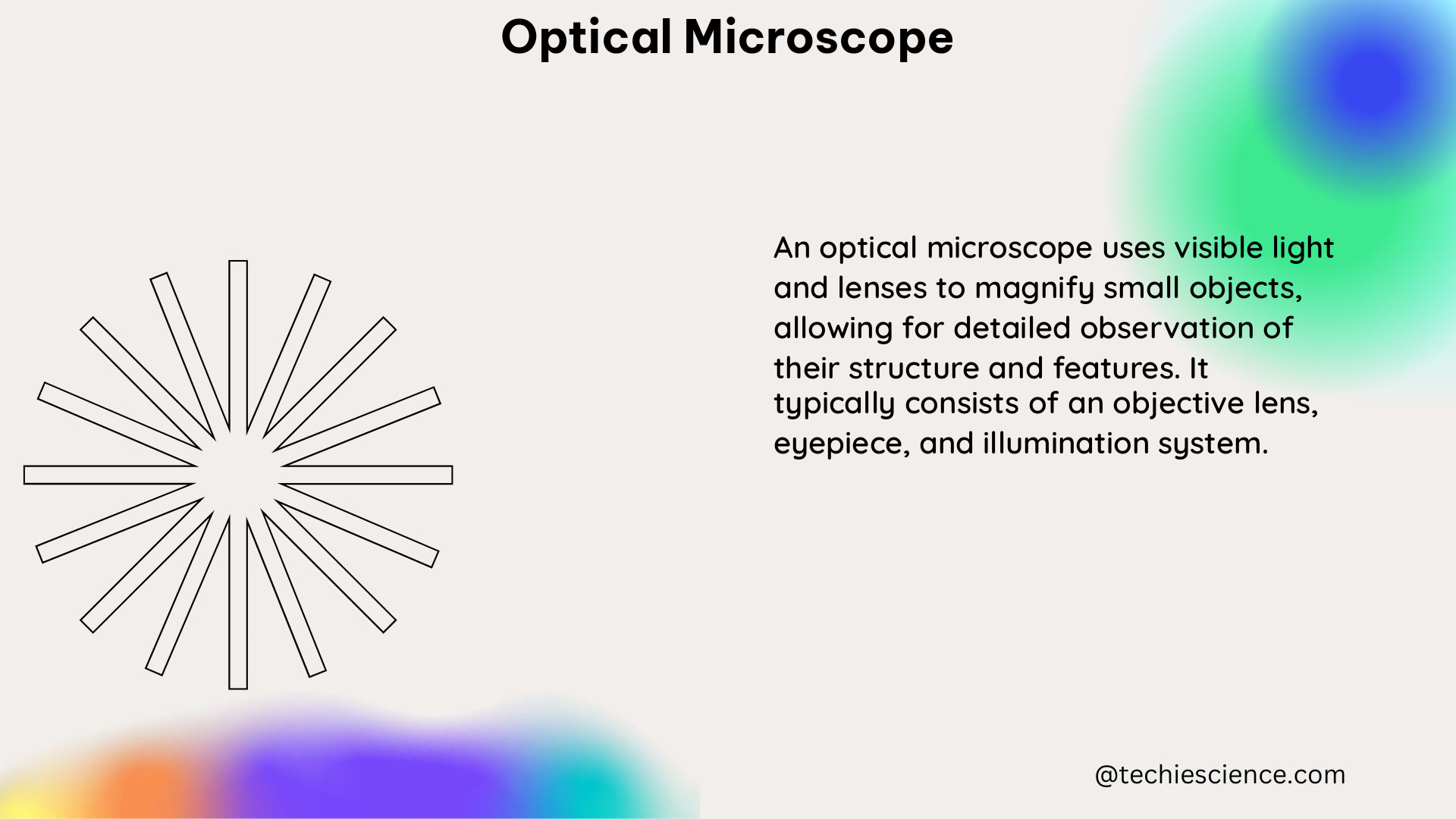Optical microscopes are versatile and powerful tools that have revolutionized scientific research and analysis across various disciplines, from biology and materials science to nanotechnology. These instruments allow researchers to observe and study the intricate details of microscopic structures, enabling them to gain valuable insights and make groundbreaking discoveries. In this comprehensive guide, we will delve into the key specifications and characteristics of optical microscopes, providing you with a deep understanding of their capabilities and how to optimize their performance for your research needs.
Magnification: Unlocking the Invisible World
The magnification of an optical microscope is a crucial parameter that determines how much larger the image appears compared to the actual object. This is typically expressed as a ratio, such as 10x, 40x, or 100x. The maximum practical magnification of an optical microscope is around 1500x, beyond which the image quality may start to deteriorate due to various optical aberrations and limitations.
The magnification of an optical microscope is determined by the combination of the objective lens and the eyepiece or camera. The objective lens is responsible for the primary magnification, while the eyepiece or camera further magnifies the image. To achieve higher magnifications, researchers can use objective lenses with higher numerical apertures (NA) and shorter focal lengths, as well as eyepieces or cameras with higher magnification factors.
Numerical Aperture (NA): The Key to Resolution

The numerical aperture (NA) of an objective lens is a measure of its ability to collect light and resolve fine details. It is defined as the sine of the half-angle of the cone of light that enters the objective lens, multiplied by the refractive index of the medium between the lens and the specimen. The higher the NA, the better the resolution and the smaller the depth of field.
The relationship between the NA and the resolution of an optical microscope is governed by the Rayleigh criterion, which states that the minimum distance between two resolvable points (d) is given by the equation:
d = 0.61 λ / NA
where λ is the wavelength of the illuminating light. This equation demonstrates that by increasing the NA of the objective lens, you can achieve a higher resolution and observe smaller details in your specimen.
Depth of Field: Balancing Focus and Clarity
The depth of field of an optical microscope is a measure of the distance over which the image remains in focus. It is inversely proportional to the square of the NA and is also affected by the magnification. A high NA and a low magnification result in a shallow depth of field, while a low NA and a high magnification result in a deep depth of field.
The depth of field (DOF) can be calculated using the following equation:
DOF = n λ / (NA)^2
where n is the refractive index of the medium between the objective lens and the specimen, and λ is the wavelength of the illuminating light.
By understanding the relationship between NA, magnification, and depth of field, researchers can optimize their microscope settings to achieve the desired balance between resolution, clarity, and the ability to observe the entire depth of the specimen.
Field of View: Capturing the Big Picture
The field of view (FOV) of an optical microscope is the area of the specimen that is visible through the eyepiece or camera. It is usually expressed in terms of the diameter of the circular field of view, and is inversely proportional to the magnification. A high magnification results in a small field of view, while a low magnification results in a large field of view.
The field of view can be calculated using the following equation:
FOV = (Eyepiece field number) / (Objective magnification)
where the eyepiece field number is a characteristic of the eyepiece and is typically provided by the manufacturer.
By adjusting the magnification and selecting the appropriate objective lens, researchers can balance the need for high-resolution imaging with the requirement to observe a larger area of the specimen.
Contrast: Enhancing Visibility
The contrast of an optical microscope is a measure of the difference in brightness between the object and its background. It is affected by the lighting, the objective lens, and the specimen itself. A high contrast results in a clear and distinct image, while a low contrast results in a faint and blurry image.
There are several techniques that can be used to enhance the contrast of an optical microscope, such as:
- Bright-field illumination: This is the most common form of illumination, where the specimen is illuminated from below, and the contrast is created by the absorption or scattering of light by the specimen.
- Dark-field illumination: In this technique, the specimen is illuminated at an angle, and the contrast is created by the scattering of light by the specimen.
- Phase contrast: This method uses the phase shift of the light passing through the specimen to create contrast, making it particularly useful for observing transparent specimens.
- Differential interference contrast (DIC): This technique uses the interference of two polarized light beams to create contrast, highlighting the edges and surface topography of the specimen.
By selecting the appropriate illumination and contrast techniques, researchers can optimize the visibility of their specimens and extract valuable information from their observations.
Illumination: Controlling the Light
The illumination of an optical microscope is a measure of the amount and quality of light that is used to illuminate the specimen. It can be transmitted (bright field), reflected (dark field), or polarized (polarization microscopy). The type and quality of illumination can affect the contrast, resolution, and depth of field of the microscope.
One of the key techniques for optimizing the illumination of an optical microscope is Köhler illumination. This method involves the use of a condenser lens and a field diaphragm to create a uniform and well-defined illumination of the specimen, minimizing the effects of uneven illumination and improving the overall image quality.
In addition to Köhler illumination, researchers can also use specialized illumination techniques, such as fluorescence microscopy, to study specific features or components of their specimens. Fluorescence microscopy relies on the use of fluorescent dyes or proteins to label specific targets within the specimen, allowing for the visualization of these structures with high contrast and sensitivity.
Image Quality: Maximizing Performance
The image quality of an optical microscope is a measure of the overall performance of the microscope in terms of resolution, contrast, depth of field, and other factors. It can be affected by many factors, including the objective lens, the illumination, the specimen, and the camera or eyepiece.
To ensure the highest possible image quality, researchers can employ various techniques and strategies, such as:
- Proper alignment and calibration: Ensuring that the optical components of the microscope are properly aligned and calibrated can significantly improve the image quality and reduce the effects of aberrations and distortions.
- Careful specimen preparation: Proper sample preparation, such as fixation, staining, and mounting, can enhance the contrast and visibility of the specimen, leading to better image quality.
- Optimization of imaging parameters: Adjusting parameters like exposure time, gain, and bit depth can help to maximize the dynamic range and signal-to-noise ratio of the acquired images.
- Image processing and analysis: Utilizing advanced image processing techniques, such as deconvolution, can further improve the resolution and clarity of the images, enabling more accurate quantitative analysis.
By understanding and applying these principles, researchers can unlock the full potential of their optical microscopes, obtaining high-quality images that provide valuable insights into the microscopic world.
Conclusion
In this comprehensive guide, we have explored the key specifications and characteristics of optical microscopes, equipping you with the knowledge to master the art of quantitative microscopy. From understanding the fundamentals of magnification and numerical aperture to optimizing illumination and image quality, this guide has provided you with a deep dive into the technical aspects of these powerful instruments.
By applying the principles and techniques outlined in this guide, you can unlock the full potential of your optical microscope, enabling you to conduct cutting-edge research, make groundbreaking discoveries, and push the boundaries of scientific exploration. Remember, the journey of mastering optical microscopy is an ongoing one, and by continuously learning and adapting, you can become a true expert in this field.
References:
- Optical Microscope – an overview | ScienceDirect Topics: https://www.sciencedirect.com/topics/engineering/optical-microscope
- Enhancing optical microscopy illumination to enable quantitative … https://www.nature.com/articles/s41598-018-22561-w
- Quantitative Optical Microscopy: Measurement of Cellular Biophysical Features with a Standard Optical Microscope https://www.ncbi.nlm.nih.gov/pmc/articles/PMC4162510/
- Measurement Uncertainty in Optical Microscopy – Cospheric https://www.cospheric.com/microscopy_measurement_uncertainty.htm
- Quantifying microscopy images: top 10 tips for image acquisition https://carpenter-singh-lab.broadinstitute.org/blog/quantifying-microscopy-images-top-10-tips-for-image-acquisition

Hi, I am Sanchari Chakraborty. I have done Master’s in Electronics.
I always like to explore new inventions in the field of Electronics.
I am an eager learner, currently invested in the field of Applied Optics and Photonics. I am also an active member of SPIE (International society for optics and photonics) and OSI(Optical Society of India). My articles are aimed at bringing quality science research topics to light in a simple yet informative way. Science has been evolving since time immemorial. So, I try my bit to tap into the evolution and present it to the readers.
Let’s connect through